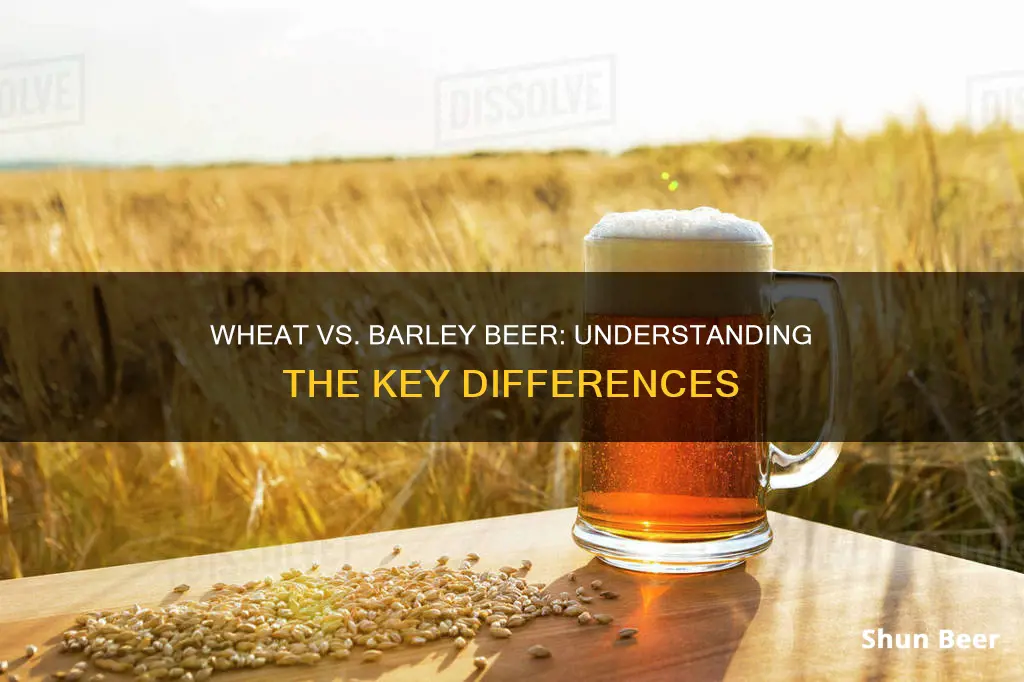
Wheat and barley are both grains that have been cultivated by humans for thousands of years and are now two of the world's major crops. They are both used in the production of alcoholic beverages, including beer, but there are some key differences between the two grains. This article will explore the differences between wheat and barley and how these differences affect the beer-making process and the final product.
What You'll Learn
- Wheat is ground into flour, barley is consumed whole or milled into barley flour
- Wheat is ranked second as a worldwide dietary staple, barley comes fourth
- Wheat is used for bread, pasta, and cakes, barley is used for animal feed and alcohol production
- Wheat is higher in protein, barley is higher in fibre
- Wheat is used for its soft, crisp flavour, barley is better for malting, mashing and brewing

Wheat is ground into flour, barley is consumed whole or milled into barley flour
Wheat and barley are both grains that have been cultivated by humans for thousands of years. Wheat is often ground into flour and used in baked goods, whereas barley is typically consumed whole or milled into barley flour.
Wheat Flour
Wheat is usually milled into flour before it is used in baked goods like bread, biscuits, cookies, pasta, noodles, semolina, bulgur, and couscous. Whole wheat flour contains all parts of the grain, including the germ, endosperm, and bran, while refined wheat flour only contains the endosperm.
Barley as a Whole Grain
Barley is a whole grain that can be consumed as-is without milling. It is often hulled to remove the outermost layer, leaving the bran, endosperm, and germ layers intact. Hulled barley is commonly used in cereals and salads, or cooked like rice in soups and stews.
Barley Flour
While barley is typically consumed whole, it can also be milled into flour. The pearled grain is ground into barley flour, which is then used in breads and other baked goods, sometimes in combination with wheat flour.
Pabst: A Wheat Beer or Not?
You may want to see also

Wheat is ranked second as a worldwide dietary staple, barley comes fourth
Wheat and barley are both grasses that have been cultivated by humans for thousands of years. Wheat is an annual grass that grows between 3 and 5 feet tall, while barley can reach heights of up to 4 feet. Wheat is ground into flour and used in a plethora of foods, while barley is consumed whole in cereals or ground into flour.
Wheat is ranked second as a worldwide dietary staple, with humans making it 19% of their diet on average. In comparison, barley comes fourth in the ranking and is cultivated in areas where wheat cannot grow, usually at extremely high altitudes.
Both wheat and barley are important in alcoholic beverage production, but wheat is used more than barley. Wheat is also a staple source of nutrients for around 40% of the world's population, providing 20% of their daily protein and food calories.
Wheat and barley have very similar characteristics and uses, but they are distinct plants. One way to tell them apart is by examining the auricles or the ear-shaped areas where the grass branches from the stem. Barley auricles do not have hairs, while wheat auricles are smaller and hairier. Additionally, the seed head of barley produces 20 to 60 grains, while wheat produces 30 to 50 grains.
In terms of growth habits, there are six basic types of wheat and two basic types of barley. Wheat is typically sown in fall or spring and harvested in spring or summer, depending on the variety. Barley, on the other hand, can be sown in both spring and fall and matures in 60 to 70 days.
When it comes to processing, wheat is usually milled into flour, bran, or whole wheat flour. Whole wheat flour includes the bran and germ, resulting in a grainier texture and additional health benefits. Barley, on the other hand, doesn't need to be milled and is processed into hulled barley for use in cereals and salads. It can also be further processed into pearled barley, which is polished hulled barley.
Both wheat and barley have important uses and provide essential nutrients. Wheat is a staple in many diets and is used in a variety of foods, while barley is commonly used in alcoholic beverage production and as animal feed.
Yuengling Beer: Is It Safe for Wheat-Free Diets?
You may want to see also

Wheat is used for bread, pasta, and cakes, barley is used for animal feed and alcohol production
Wheat and barley are both grains that have been cultivated by humans for thousands of years. While they share some similarities, they are also used for distinct purposes.
Wheat is a grass cultivated for its seeds, which are a staple food around the world. It is typically ground into flour and used for baking goods such as bread, biscuits, cookies, pasta, noodles, semolina, bulgur, and couscous. Wheat is also commonly used in breakfast cereals and can be fermented to make alcoholic beverages like beer.
On the other hand, barley is also a versatile grain with a chewy consistency and a slightly nutty flavor. It is commonly used in animal feed and alcohol production, particularly for beer. However, it can also be cooked and used in soups, stews, breakfast cereals, and baby food. Additionally, barley can be milled into flour and used in baked goods, although this is less common.
In terms of nutritional content, both wheat and barley are rich in vitamins, minerals, and fiber. However, barley is particularly known for its high fiber content, which can promote better digestion, lower cholesterol, and improve heart health. Wheat, on the other hand, is a significant source of carbohydrates and vegetable proteins, with a protein content of about 13%.
While wheat is primarily used for baking and cereal products, barley is more commonly used in brewing and animal feed. However, both grains offer a range of nutritional benefits and can be incorporated into various dishes.
German Beer: Wheat, Wonder, and Beyond
You may want to see also

Wheat is higher in protein, barley is higher in fibre
Wheat beer and barley beer are both made from grains, but they have distinct differences in terms of their nutritional content, processing methods, and usage.
When it comes to nutrition, wheat is higher in protein, while barley is higher in fibre. This is because, in its unprocessed form, wheat contains more insoluble fibre, whereas barley is a good source of soluble fibre, specifically beta-glucan. Beta-glucan has been linked to improved cholesterol and blood sugar control, making barley a healthier option in this regard.
In terms of processing, wheat needs to be milled before use, whereas barley does not require milling and is typically consumed as a whole grain. Whole wheat flour, which contains all parts of the grain, is more nutritious than refined wheat flour, which has lost a significant amount of fibre, minerals, and vitamins during processing. On the other hand, barley can be consumed as hulled barley, with all parts of the grain intact, or pearled barley, which has had the bran and hull removed, reducing its fibre content.
Wheat is commonly used in baking and is ground into flour to make a variety of products, including bread, biscuits, pasta, and noodles. Barley, on the other hand, is primarily used in brewing and livestock feed. It is also cooked whole, similar to rice, and used in soups, stews, and porridge.
Wheat Beer's Sweet Escape From Bitterness
You may want to see also

Wheat is used for its soft, crisp flavour, barley is better for malting, mashing and brewing
Wheat and barley are both grains that have been used in brewing for centuries. While barley is the most common grain used in brewing, wheat is also used, especially in wheat beers, and in smaller quantities in other beer styles.
Wheat is used for its soft, crisp flavour, which works well as a background for additions of berries and other fruits. Wheat also has a higher level of protein compared to barley, which can contribute to a beer's appearance, making it hazier, and enhancing its foam stability. Wheat can also make a beer's body fuller, increasing the mouthfeel (the sensation of fullness in the drinker's mouth).
Barley, on the other hand, is better for malting, mashing and brewing. Barley has an excellent starch-to-protein ratio and provides the enzymes needed for the mashing stage of brewing. The structure of barley and its enzyme levels mean that it can quickly and easily break down starches into fermentable sugars. This makes barley ideal for the malting process, where the grains are soaked in water, germinated, and then roasted to dry out the grain and stop germination.
While wheat can be malted, the process is more difficult due to wheat's lack of a thick husk, which means it absorbs water more quickly and reaches modification faster than barley. Wheat malt is also relatively less modified than barley malt and is kilned at lower temperatures, resulting in a slightly darker colour even in the palest wheat malt.
In summary, while both wheat and barley have their place in brewing, wheat is used primarily for its soft, crisp flavour and its ability to enhance a beer's appearance and mouthfeel. Barley, on the other hand, is favoured for malting, mashing and brewing due to its ideal structure, enzyme levels, and starch-to-protein ratio.
Sour Beers: Do They Contain Wheat?
You may want to see also
Frequently asked questions
Wheat and barley have very similar characteristics and uses, but they are not the same plant. Wheat is an annual grass that grows between 3 and 5 feet tall. Barley, on the other hand, is a grass that reaches up to 4 feet tall. The seed head of barley produces 20 to 60 grains, while that of wheat produces 30 to 50 grains.
There are six basic types of wheat and two basic types of barley. Wheat types include Hard Red Winter Wheat, Hard Red Spring Wheat, Soft Red Winter Wheat, Soft White Wheat, Hard White Wheat, and Durum Wheat. The two types of barley are Six-Row Barley and Two-Row Barley.
Wheat is usually milled into wheat flour, wheat bran, or whole wheat flour, while barley doesn't need to be milled and is often consumed as a whole grain or ground into barley flour. Wheat is commonly used in baked goods, while barley is used in cereals, salads, and soups.
Both wheat and barley are rich in dietary fiber, but barley has a higher fiber content. Barley also contains higher amounts of beta-glucans, which are beneficial for blood sugar control and lowering cholesterol. Wheat is higher in manganese, while barley has higher levels of zinc, iron, magnesium, and potassium.
Both wheat and barley contain gluten and are not suitable for individuals with celiac disease or gluten sensitivity. Wheat has been linked to irritable bowel syndrome and gluten intolerance, while barley may be a better option for those with specific wheat gluten allergies.







